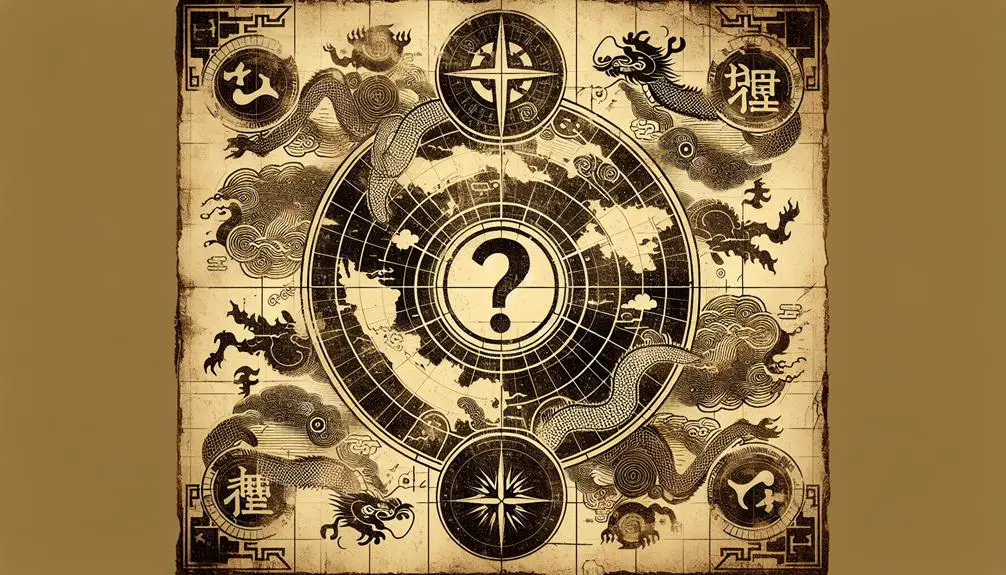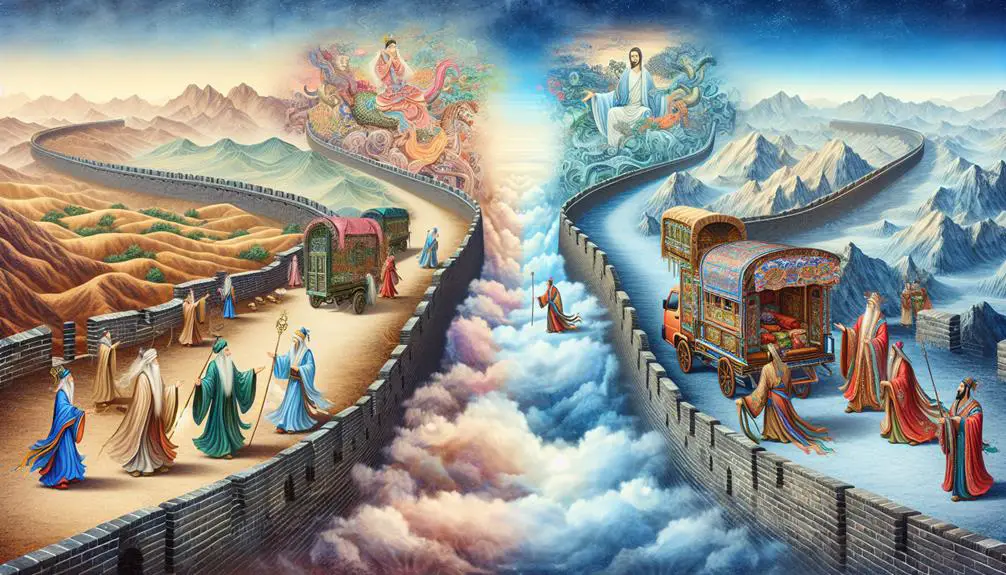This exploration delves into the biblical references of 'Sinim', igniting curiosity about China's ancient connection to the scriptures.

Is China in the Bible
Navigating the historical tapestry of the Bible, you might find yourself at a crossroads when pondering whether China, a civilization as ancient as the stories within the holy scriptures, makes an appearance.
As you sift through Biblical references and interpretations of the term 'Sinim', often thought to allude to distant lands, the question isn't merely about geographical mentions but bridges ancient civilizations and their interconnectedness.
Scholarly perspectives offer a kaleidoscope of views, yet, the intrigue lies not just in pinpointing a name on a map but in understanding how these ancient narratives intertwine.
Let's explore this junction of history and scripture, where knowledge and mystery meet.
Key Takeaways
- Direct references to China are absent in the Bible due to its Near East focus.
- Scholars debate indirect mentions, like 'Sinim', due to translation and interpretation challenges.
- Cultural exchanges via the Silk Road facilitated the spread of religious ideas between regions.
- Archaeological findings, such as the Nestorian Stele, suggest early Christian presence in China.
Historical Context and Geography

Examining the historical context and geography, it's clear that references to China in the Bible aren't explicitly mentioned, given the geographical focus and historical period of the biblical texts. The Bible predominantly revolves around the Near East, encompassing lands that are now Israel, Palestine, and surrounding territories. During the times chronicled in the Bible, the Silk Road was emerging as a series of critical trade routes that interconnected the East and West. However, the Silk Road's full development and significance came after the principal biblical narratives were penned.
You must understand that the Bible's primary narratives were shaped well before the Silk Road facilitated extensive cultural and economic exchanges between the East and West. Although trade routes existed that could have connected regions of the biblical world with distant lands such as China, these weren't the central focus of biblical authors. Their primary concern was with the immediate geographical and cultural contexts in which they lived. Therefore, while indirect interactions through trade could have influenced the broader historical backdrop, direct references to China or its specific cultures are absent from the biblical texts, reflecting their geographical and historical context.
Biblical References Explored

Having established the historical and geographical context, let's now explore specific biblical references to determine if there are any indirect mentions or allusions to China within the scriptures. The task involves navigating through translation challenges and understanding the cultural impacts that might have influenced the biblical text.
One primary challenge in identifying references to China is the dynamic nature of language, especially across translations. Ancient texts don't always translate neatly into modern languages, and specific names or places can have multiple interpretations. This ambiguity necessitates a careful, scholarly approach to discern possible allusions to China.
Challenge |
Impact |
|---|---|
Translation |
Variations in translations can obscure direct and indirect references. |
Cultural Context |
Understanding the cultural milieu of the times aids in interpretation. |
Furthermore, the cultural impacts on the biblical text are significant. The scriptures were written in a time and place far removed from ancient China, both geographically and culturally. This distance means that any references to China would likely be indirect, viewed through the lens of the cultures that produced the biblical texts. Thus, identifying possible allusions requires a nuanced understanding of both the biblical cultural context and the historical interactions between these ancient civilizations.
Interpretations of "Sinim

While exploring biblical references, one term that sparks debate among scholars is 'Sinim', potentially alluding to an ancient understanding of China. This term, nestled within ancient texts, opens a dialogue on how geographical locations are interpreted through the lens of language barriers and cultural symbolism.
Delving into 'Sinim' requires a nuanced approach to understand its potential references to China, considering:
- Language Barriers: Ancient texts traverse through centuries, facing translations and reinterpretations. The word 'Sinim' is a prime example of how language evolution affects our understanding of historical references. Scholars dissect linguistic roots to bridge gaps between ancient languages and modern interpretations, a task fraught with challenges.
- Cultural Symbolism: The mention of 'Sinim' also invites a discussion on cultural symbolism, considering how ancient civilizations perceived foreign lands. Understanding 'Sinim' within its biblical context requires an analysis of how distant lands were symbolized in ancient texts, reflecting broader cultural perceptions and biases.
- Geographical Identifications: Linking 'Sinim' to modern-day China involves geographical identifications based on historical and archeological evidence. This process is complex, as it intertwines with interpretations of ancient maps and travel accounts.
These facets highlight the intricate process of deciphering biblical references to geographical locations like 'Sinim', showcasing the interplay between language, culture, and historical evidence.
Scholarly Perspectives

Scholars offer varied interpretations of 'Sinim', reflecting the complexities of linking this term to China within biblical texts. You'll find that translation challenges significantly contribute to these varied viewpoints. Ancient languages, such as Hebrew, don't directly map onto modern languages or concepts, making the task of translation less straightforward than it might appear. This isn't merely a matter of finding equivalent words, but also of understanding the historical and cultural context in which the original text was written.
Furthermore, cultural biases play a substantial role in how scholars interpret these ancient texts. Researchers' cultural backgrounds and personal beliefs can influence their interpretations, leading to a range of perspectives on whether 'Sinim' refers to China or some other region. This diversity of thought demonstrates how interpretations aren't only about linguistic accuracy but also about the broader context in which scholars operate.
In navigating these scholarly perspectives, it's crucial to approach the question of 'Sinim' with an awareness of these underlying challenges. Translation isn't just a linguistic exercise, but also a cultural and historical one, where biases and complexities intertwine to shape our understanding of ancient texts.
Bridging Ancient Civilizations

Exploring the connections between ancient civilizations reveals the intricate web of trade, cultural exchange, and shared knowledge that potentially links regions as distant as China to the biblical narratives. The Silk Road, a network of trade routes, stands as a testament to these connections, facilitating not just the exchange of goods but also of ideas, technologies, and religious beliefs across continents.
To understand the depth of these interactions, consider:
- The Silk Road's Role: It wasn't just a conduit for silk but also for spreading philosophies, innovations, and religious texts, making it a crucible for cultural exchange.
- Technological and Agricultural Exchange: Techniques in paper-making, silk production, and even specific crops traveled along these routes, significantly impacting the societies they reached.
- Religious and Philosophical Influence: Ideas from Buddhism, Christianity, and other religions were exchanged along the Silk Road, influencing beliefs and practices far from their origins.
These points underscore the complexity and richness of the interactions between ancient civilizations. The Silk Road facilitated a cultural exchange that had a profound impact on the development of societies, suggesting that the connections between China and the biblical narratives aren't just plausible but deeply rooted in history.
Frequently Asked Questions
How Do Modern Chinese Christians View the Potential References to China in the Bible?
You might find it intriguing how modern Chinese Christians navigate the interpretive challenges when looking at potential references to China in the Bible.
It's a quest that deeply influences their spiritual identity. They often engage in scholarly analysis, weighing historical context against scriptural texts, to discern if these references genuinely speak to their heritage.
This reflective process showcases an objective, analytical approach to understanding their faith within a broader, global Christian narrative.
Are There Any Specific Chinese Cultural Practices or Traditions That Parallel Biblical Stories or Teachings?
You'll find that certain Chinese cultural practices and traditions echo biblical stories or teachings.
For example, the Chinese Zodiac, in its cyclic representation of time, may remind you of biblical cycles of redemption and judgement.
Similarly, Confucian ethics, with its emphasis on respect, righteousness, and loyalty, parallels the moral teachings found in the Bible, especially those concerning how to treat others and live a virtuous life.
Have Recent Archaeological Discoveries in China Provided Any New Insights Into the Bible's Historical Narratives?
Recent archaeological discoveries in China have unearthed ancient manuscripts that shine a new light on the Silk Road trade's impact on biblical narratives. These findings offer a unique lens, bridging continents and cultures, to reconsider how interconnected ancient civilizations were.
While you won't find a direct mention of China in the Bible, these manuscripts provide compelling evidence of indirect influences and exchanges that enriched the historical context of biblical stories.
How Do Contemporary Geopolitical Tensions Between China and Other Nations Influence Interpretations of These Potential Biblical References?
Contemporary geopolitical tensions between China and other nations can significantly influence your understanding of prophecy interpretations and political symbolism in biblical texts.
As you analyze these texts, it's essential to recognize how current political climates may shape or reframe traditional interpretations.
This analytical perspective allows for a more nuanced view, considering how modern conflicts and alliances could be viewed through a lens of prophetic or symbolic significance within a scholarly and objective framework.
In What Ways Have Chinese Languages and Dialects Been Used to Translate and Understand the Bible, and How Might This Impact the Perception of China's Presence in Biblical Texts?
Diving into the world of biblical translations, you'll find that Chinese languages and dialects pose unique challenges. The sheer dialect diversity complicates the task, yet enriches understanding when meticulously navigated.
These translation challenges not only influence how the Bible is comprehended but also subtly shape perceptions of China's historical presence within biblical narratives. Analyzing these translations offers a scholarly lens through which to view the intersection of language, culture, and ancient texts.
Conclusion
In conclusion, while the Bible doesn't explicitly mention China, the scholarly consensus leans towards interpreting 'Sinim' as a reference to a region far east, possibly ancient China.
This exploration bridges ancient civilizations, offering a glimpse into how interconnected our histories might be. Imagine a Silk Road trader, carrying scrolls of Isaiah alongside silk, unknowingly weaving together the tapestry of human civilization.
This analytical journey not only enriches our understanding but also evokes a profound appreciation for the shared narrative of humanity.



Sign up